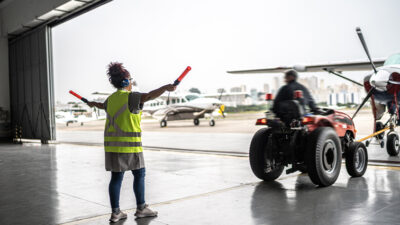Understanding the Effect of Increased Aviation Demand and Fatigue on Pilots

The COVID-19 pandemic has taken its toll on the aviation industry, with travel restrictions and flight cancellations severely impacting air travel over the past three years. Business aviation was one of the most impacted air travel sectors, as organizations opted for virtual meetings or found other ways to engage remotely with their clients and colleagues.
However, business travel has since rebounded, with many companies reporting that corporate travel budgets have returned to pre-pandemic levels despite the increased cost of airfare, according to Morgan Stanley. Executives at Airbus Corporate Jets anticipate that 2023 will see a higher number of business professionals choosing to fly on private or chartered flights. While surely welcome, what impact does this resurgence of flight demand have on the well-being of pilots?
Pilot Shortages and Fatigue
Even before the pandemic, it was predicted that a shortage of pilots was forthcoming, as members of the baby-boom generation neared the federally mandated retirement age of 65. At the same time, the costs and time required to obtain a pilot certification have continued to rise, serving as a major deterrent for individuals considering aviation as a career choice. The broader airline industry estimated a shortage of nearly 8,000 pilots in 2022. Unfortunately, this shortage is likely to persist.
Analysts predict that the industry will be faced with a shortage of nearly 24,000 pilots by the year 2026, which is equivalent to the elimination of approximately 23% of the current pilot workforce. With decreasing availability of qualified labor and rising air travel demand, the industry is acutely feeling the challenge. And pilots are carrying the burden with more work hours, declining productivity and increased fatigue.
The International Air Transport Association (IATA) expects the airline industry as a whole to post a net profit of $4.7 billion in 2023. Perhaps this inflow of capital will help stimulate new investments to help tackle the problem of pilot fatigue. Ultimately, it is up to air operators to create safer working conditions for pilots and attract the skilled personnel needed to meet air travel demand safely and reliably.
The Causes of Pilot Fatigue
While the persistent shortage of pilots plays a significant role in pilot fatigue, there are other factors to consider. Flight delays due to antiquated IT systems and scheduling issues are also to blame. In April 2022, the Southwest Airlines Pilots Association reported record-setting fatigue levels.
According to the organization’s president, Casey Murray, “A lot of our delays and issues that we’re having have to do with scheduling and connecting pilots with airplanes. It is inefficient scheduling processes that are affecting when we work in a very dynamic environment.” This is becoming not only a problem for aviation in the United States but globally. According to the Australian Transport Bureau, a third of pilots have reported removing themselves from duty because of fatigue, an action they unfortunately felt was looked down upon by superiors.
On top of scheduling practices, an often overlooked source of pilot fatigue is individual factors. A new baby at home. Online courses. A medical condition that makes it difficult to achieve high-quality sleep. The list of what can influence a pilot’s ability to get adequate rest each day is long and varied, but the fact remains: Arriving for duty rested and alert is as much a function of what’s going on at home as it is linked to the schedule at work. Just losing 30 to 60 minutes of sleep a night can quickly create a sleep debt that contributes to pilot fatigue.
Managing Pilot Fatigue Amid Increasing Air Travel Demand
As part of their overarching commitment to safety, air operators have a duty to remain aware of the dangers of pilot fatigue and take the necessary steps to mitigate risk. A key step toward this objective is to implement a comprehensive Fatigue Risk Management Program (FRMP).
An FRMP employs multi-layered defensive strategies to manage fatigue-related risks regardless of their source. It includes data-driven, ongoing adaptive processes that can identify fatigue hazards as they appear, perform risk assessments, implement and evaluate controls and mitigation strategies and monitor performance. A successful FRMP allows the organization to conduct operations not only more safely, but also more efficiently.
This flexibility is crucial to help the organization meet rising demand with resources that are fixed or expanding more gradually. A guide for utilizing fatigue risk management systems created in partnership with IATA, the International Civil Aviation Organization (ICAO) and the International Federation of Air Line Pilots’ Associations (IFALPA) can help aviation businesses implement these invaluable tools.
Pulsar Informatics helps air operators develop and implement a complete FRMP that integrates fatigue risk management directly into their workflows. Our products are designed to enable operators to actively manage fatigue to not only improve safety and save costs but also manage growing demand and help meet evolving regulatory requirements.
Contact us today to learn how an FRMP can deliver benefits to your organization.

Pulsar Informatics is an IS-BAO I3SA certified company specializing in systems that help organizations reduce fatigue-related risk and achieve peak performance. Fleet Insight enables safety managers and schedulers to proactively evaluate fatigue across their entire operation’s schedule and formulate mitigation strategies. Fatigue Meter Pro Planner is used by pilots, flight attendants, and maintenance personnel to evaluate their individual flight and duty schedule.
http://www.pulsarinformatics.com
© 2024 Pulsar Informatics, Inc.. All Rights Reserved.
Next ArticleRelated Posts

More Than a Box Tick: Achieving Operational Flexibility With an FRMS
Moms know best. This adage holds true in many domains of family life—allergies, grades, crushes. When thinking about aviation safety, though, perhaps the best illustration drawn from mom’s expertise is…

The Effects of a Learning Mindset on Safety Culture
As aviation departments strive to enhance their safety performance, a critical yet often overlooked element is the need to foster a learning-culture mindset. This mindset shift can unlock invaluable opportunities for continuous improvement, employee engagement and creating a resilient safety environment. From a behavioral management perspective, as your company’s learning culture goes, so goes the ongoing success of your SMS.

